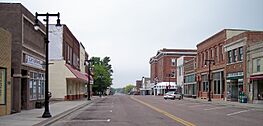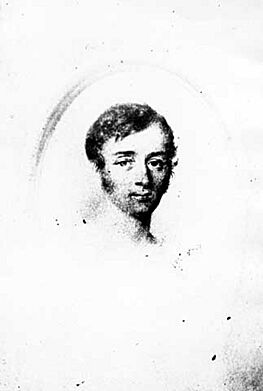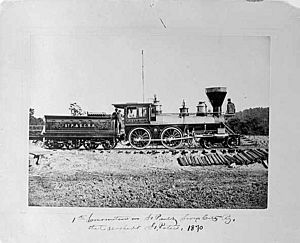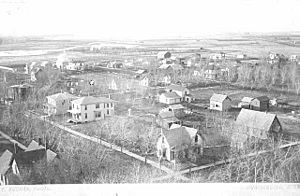Worthington, Minnesota facts for kids
Quick facts for kids
Worthington, Minnesota
|
|
|---|---|
|
Tenth Street in downtown Worthington in 2007
French explorer Joseph Nicollet
First train on the St Paul & Sioux City Railway
Worthington in 1893
|
|

Location of Worthington in Nobles County, Minnesota
|
|
| Country | United States |
| State | Minnesota |
| County | Nobles |
| Founded | 1871 |
| Incorporated | April 29, 1872 |
| Government | |
| • Type | Mayor–Council |
| Area | |
| • City | 9.337 sq mi (24.183 km2) |
| • Land | 7.952 sq mi (20.596 km2) |
| • Water | 1.385 sq mi (3.588 km2) |
| Elevation | 1,572 ft (479 m) |
| Population
(2020)
|
|
| • City | 13,947 |
| • Estimate
(2023)
|
13,614 |
| • Density | 1,714.57/sq mi (661.99/km2) |
| • Urban | 13,800 |
| • Metro | 21,727 (US: 496th) |
| Time zone | UTC–6 (Central (CST)) |
| • Summer (DST) | UTC–5 (CDT) |
| ZIP Code |
56187
|
| Area code(s) | 507 and 924 |
| FIPS code | 27-71734 |
| GNIS feature ID | 2397378 |
| Sales tax | 7.875% |
Worthington is a city in and the county seat of Nobles County, Minnesota, United States. The population was 13,947 at the time of the 2020 census.
Contents
History
The first European likely to have visited the Nobles County area of southwestern Minnesota was French explorer Joseph Nicollet. Nicollet mapped the area between the Mississippi and Missouri Rivers in the 1830s. He called the region “Sisseton Country” in honor of the Sisseton band of Dakota Indians then living there. It was a rolling sea of wide open prairie grass that extended as far as the eye could see. One small lake in Sisseton Country was given the name “Lake Okabena” on Nicollet’s map, “Okabena” being a Dakota word meaning “nesting place of the herons.”
The town of Worthington was founded by "Yankees" (immigrants from New England and upstate New York who were descended from the English Puritans who settled New England in the 1600s).
In 1871, the St. Paul & Sioux City Railway Company began connecting its two namesake cities with a rail line. The steam engines of that time required a large quantity of water, resulting in water stations being needed every eight to twelve miles (19 km) along their routes. One of these stations, at the site of present-day Worthington, was designated as “The Okabena Railway Station.”
Meanwhile, in that same year, Professor Ransom Humiston of Cleveland, Ohio, and Dr. A.P. Miller, editor of the Toledo Blade, organized a company to locate a colony of New England settlers who had already settled in Northern Ohio along the tracks of the Sioux City and St. Paul Railway. These were people were "Yankee" settlers whose parents had moved to the region of Northeast Ohio known as the Connecticut Western Reserve from the six New England states. These settlers were primarily members of the Congregational Church, though due to the Second Great Awakening, many of them had converted to Methodism and Presbyterianism, and some had become Baptists before coming to what is now Minnesota. This colony – the National Colony – was to be a village of temperance, a place where evangelical Methodists, Presbyterians, Congregationalists, and Baptists could live free of the temptations of alcohol. A town was plotted, and the name was changed from the Okabena Railway Station to Worthington - Worthington being the maiden name of Dr. Miller’s mother-in-law. On April 29, 1872, regular passenger train service to Worthington was started, and on that very first train were the first of the National Colony settlers. One early arrival described the scene:
We were among the first members of the colony to arrive at the station of an unfinished railroad… There was a good hotel, well and comfortably furnished, one or two stores neatly furnished and already stocked with goods, [and] several other[s] in process of erection… The streets, scarcely to be defined as such, were full of prairie schooners, containing families waiting until masters could suit themselves with “claims,” the women pursuing their housewifely avocations meanwhile – some having cooking stoves in their wagons, others using gypsy fires to do their culinary work; all seeming happy and hopeful.
Some settlers from New England were however, drinking men, most of whom were civil war veterans from Massachusetts and Maine, who came into conflict with the temperance movement. A curious event took place on Worthington’s very first Fourth of July celebration. Hearing that there was a keg of beer in the Worthington House Hotel, Professor Humiston entered the hotel, seized the keg, dragged it outside, and destroyed it with an axe. A witness described what happened next:
''Upon seeing this, the young men of the town thought it to be rather an imposition, and collected together, procured the services of the band, and under the direction of a military officer marched to the rear of the hotel, and with a wheelbarrow and shovel took the empty keg that had been broken open, and playing the dead march with flag at half staff marched to the flagpole in front of Humiston’s office where they dug a grave and gave the empty keg a burial with all the honors attending a soldier’s funeral.
They then, with flag at full mast and with lively air, marched back to the ice house, procured a full keg of beer, returning to the grave, resting the keg thereon. Then a general invitation was given to all who desired to partake, which many did until the keg was emptied… In the evening they reassembled, burning Prof. Humiston in effigy about 10 p.m. Thus ended the glorious Fourth at Worthington, Minn. —Sibley Gazette July 5, 1872
In spite of tensions between pro-temperance and anti-temperance factions, the town grew rapidly. By the end of summer in 1872, eighty-five buildings had been constructed where just one year before there had been nothing but a field of prairie grass.
Settlers poured into the region. At first they came almost exclusively from the six New England states due to issues of overpopulation combined with land shortages, which led to a stream of "Yankee" immigrants leaving that region. Some had come from Upstate New York and had parents and grandparents who had moved to that region from New England during the early 1800s and late 1700s. Due to the large number of New Englanders and New England transplants from upstate New York the town of Worthington, like much of Minnesota at this time, was very culturally continuous with early New England culture for much of its early history. It was the age of the Homestead Act when 160 acres (0.65 km2) of government land could be claimed for free. All one had to do was live on the land and “improve” it, a vague phrase if ever there was one. In such an atmosphere, settlers without connection to the National Colony also arrived in great number, and few of those were temperance activists. The ensuing winter was a severe one, and swarms of grasshoppers stripped farmers’ fields bare in the summer of 1873. Still, settlers came. 1874 produced a bumper harvest, followed by another grasshopper invasion in 1875. 1876 and 1877 were both good farming years. Grasshoppers returned for the last time in 1879, and a bright future began for southwestern Minnesota. According to the 1880 census, Nobles County boasted 4435 residents, 636 of them living in Worthington.
In the early 1900s German immigrants began arriving in Worthington in large numbers, though this later group did not come directly from Germany, but rather (mostly) came to Worthington from other places in the midwest, especially the state of Ohio, where their communities had already been established.
Unlike other parts of the country, the Germans were not subjected to xenophobia in Nobles County, Minnesota but rather were welcomed with open arms by the "Yankee" population who had established the town. This led to many writing back to Ohio, which led to chain migration to the region which greatly increased the German-American population. The "Yankee" population of old stock Americans of English descent did not come into conflict with the German-American community for much of their early history together in what is now Worthington. However eventually the two communities would be divided on the issue of World War I in which the Yankee community would be divided and the Germans were unanimously opposed to American entry into the war. The Yankee community was generally pro-British, however many of the Yankees also did not want America to enter the war themselves. The Germans were sympathetic to Germany and did not want the United States to enter into a war against Germany, but the Germans were not anti-British. Prior to World War I, many German community leaders in Minnesota and Wisconsin spoke openly and enthusiastically about how much better America was than Germany, due primarily (in their eyes) to the presence of English law and the English political culture the Americans had inherited from the colonial era, which they contrasted with the turmoil and oppression in Germany which they had so recently fled. Other immigrant groups followed the Germans including setters from Ireland, Norway and Sweden. For German, Irish and Scandinavian immigrants seeking a new life, southwestern Minnesota was a new world.
On December 12, 2006 the Immigration and Customs Enforcement (I.C.E) staged a coordinated predawn raid at the Swift & Company meat packing plant in Worthington and at five other Swift plants in western states, interviewing workers and hauling hundreds off in buses.
Geography
According to the United States Census Bureau, the city has a total area of 8.74 square miles (22.64 km2), of which 7.34 square miles (19.01 km2) is land and 1.40 square miles (3.63 km2) is water.
Demographics
| Historical population | |||
|---|---|---|---|
| Census | Pop. | %± | |
| 1880 | 636 | — | |
| 1890 | 1,164 | 83.0% | |
| 1900 | 2,386 | 105.0% | |
| 1910 | 2,385 | 0.0% | |
| 1920 | 3,481 | 46.0% | |
| 1930 | 3,878 | 11.4% | |
| 1940 | 5,918 | 52.6% | |
| 1950 | 7,923 | 33.9% | |
| 1960 | 9,015 | 13.8% | |
| 1970 | 9,916 | 10.0% | |
| 1980 | 10,243 | 3.3% | |
| 1990 | 9,977 | −2.6% | |
| 2000 | 11,283 | 13.1% | |
| 2010 | 12,764 | 13.1% | |
| 2020 | 13,947 | 9.3% | |
| 2023 (est.) | 13,614 | 6.7% | |
| U.S. Decennial Census 2020 Census |
|||
The U.S. Bureau of Census now classifies Worthington as a micropolitan area, with a population of 20,508. The area has had a relatively high level of immigration, mostly Hispanics, in the early 21st century. Some sources credit this immigration trend for revitalizing the city's economy, which had been constrained by a shrinking population.
As of the 2022 American Community Survey, there are 4,570 estimated households in Worthington with an average of 2.92 persons per household. The city has a median household income of $58,690. Approximately 15.4% of the city's population lives at or below the poverty line. Worthington has an estimated 62.4% employment rate, with 15.8% of the population holding a bachelor's degree or higher and 70.3% holding a high school diploma.
The top five reported ancestries (people were allowed to report up to two ancestries, thus the figures will generally add to more than 100%) were English (54.5%), Spanish (32.7%), Indo-European (0.4%), Asian and Pacific Islander (7.0%), and Other (5.4%).
The median age in the city was 33.1 years.
2020 census
| Race / Ethnicity | Pop 2000 | Pop 2010 | Pop 2020 | % 2000 | % 2010 | % 2020 |
|---|---|---|---|---|---|---|
| White alone (NH) | 7,934 | 6,238 | 4,864 | 70.32% | 48.87% | 34.88% |
| Black or African American alone (NH) | 205 | 682 | 946 | 1.82% | 5.34% | 6.78% |
| Native American or Alaska Native alone (NH) | 33 | 51 | 38 | 0.29% | 0.40% | 0.27% |
| Asian alone (NH) | 783 | 1,081 | 1,248 | 6.94% | 8.47% | 8.95% |
| Pacific Islander alone (NH) | 0 | 7 | 0 | 0.00% | 0.05% | 0.00% |
| Some Other Race alone (NH) | 9 | 21 | 28 | 0.08% | 0.17% | 0.20% |
| Mixed Race/Multi-Racial (NH) | 144 | 163 | 225 | 1.28% | 1.28% | 1.61% |
| Hispanic or Latino (any race) | 2,175 | 4,521 | 6,559 | 19.28% | 35.42% | 47.03% |
| Total | 11,283 | 12,764 | 13,947 | 100.00% | 100.00% | 100.00% |
Note: the US Census treats Hispanic/Latino as an ethnic category. This table excludes Latinos from the racial categories and assigns them to a separate category. Hispanics/Latinos can be of any race.
2010 census
As of the census of 2010, there were 12,764 people, 4,458 households, and 2,917 families residing in the city. The population density was 1,739.0 inhabitants per square mile (671.4/km2). There were 4,699 housing units at an average density of 640.2 per square mile (247.2/km2). The racial makeup of the city was 62.2% White, 5.5% African American, 0.7% Native American, 8.6% Asian, 0.1% Pacific Islander, 20.5% from other races, and 2.4% from two or more races. Hispanic or Latino of any race were 35.4% of the population.
There were 4,458 households, of which 34.7% had children under the age of 18 living with them, 48.4% were married couples living together, 10.7% had a female householder with no husband present, 6.3% had a male householder with no wife present, and 34.6% were non-families. 28.4% of all households were made up of individuals, and 13.9% had someone living alone who was 65 years of age or older. The average household size was 2.79 and the average family size was 3.36.
The median age in the city was 33.5 years. 26.8% of residents were under the age of 18; 10.7% were between the ages of 18 and 24; 26.1% were from 25 to 44; 21.3% were from 45 to 64; and 15% were 65 years of age or older. The gender makeup of the city was 51.1% male and 48.9% female.
Arts and culture
Worthington hosts many annual events: Windsurfing Regatta & Music Festival (June), International Festival (July), King Turkey Day (September), and Holiday Parade (November).
Education
Worthington is served by Independent School District 518. Worthington's school mascot is the Trojan, and its high school athletic teams play in the Big South Conference. ISD 518 is known regionally for its robust music program offerings, with band, string orchestra, choir, and theater ensembles open to all students. Worthington Senior High School's 'Spirit of Worthington' Trojan Marching Band, with over 160 members, is an ensemble that has performed nationally 5 times. The Trojans' performances included two at the 75th and 78th annual McDonald's Thanksgiving Day Parade in Chicago in 2008 and 2011, respectively. In 2019, the Trojans were a featured band at the Chick-fil-A Peach Bowl in Atlanta, Georgia.
- High School: Worthington High School Worthington Senior High School
- Middle School: Worthington Middle School
- Elementary School: Prairie Elementary School
Worthington's private, parochial schools include:
- Worthington Christian School, which serves grades K-8.
- St. Mary's Elementary School, which serves grades K-6.
Worthington's local higher education institution is Minnesota West Community and Technical College. Minnesota West's Worthington campus is a two-year college that offers associate degrees in a wide variety of majors, along with diplomas and certificates in areas from practical nursing to accounting, among others.
Worthington and the surrounding area are served by the Nobles County Library, part of the Plum Creek Library System, which is based in the city.
Infrastructure
Transportation
Transit
- Prairieland Transit System
Highways
 Interstate 90
Interstate 90 U.S. Route 59
U.S. Route 59 Minnesota State Highway 60
Minnesota State Highway 60 Minnesota State Highway 266 (decommissioned - designated as Nobles County Road 25)
Minnesota State Highway 266 (decommissioned - designated as Nobles County Road 25) Nobles County Road 25
Nobles County Road 25 Nobles County Road 35
Nobles County Road 35
Media
The Globe serves Worthington, Nobles County, and surrounding areas with a print newspaper, an e-paper and website. It was purchased by the Forum Communications Company in 1995 and publishes a print edition on Wednesdays and an e-edition on Saturdays.
Notable people
- Dwayne Andreas, CEO of Archer Daniels Midland and political donor, was born in Worthington
- Wayne R. Bassett Sr., librarian and Minnesota state legislator
- William Elijah Bloom, Minnesota state legislator
- Wendell Butcher, football player
- George Dayton, banker and real estate developer in Worthington before moving to Minneapolis
- Matt Entenza, former minority leader of Minnesota House of Representatives and 2010 DFL candidate for governor of Minnesota
- Gordon Forbes, lawyer and Minnesota state legislator
- Francis G. Judge, electrician, businessman, and Minnesota state legislator
- Big Tiny Little, pianist and television personality
- Peter Ludlow, prominent analytic philosopher
- Stephen Miller, fourth Governor of Minnesota
- Gordon Moore (judge), Associate Justice of the Minnesota Supreme Court
- Lee Nystrom, NFL player, was born in Worthington
- Tim O'Brien, novelist known for Vietnam War literature
- John Olson, state senator and Worthington native
Sister city
There is a sister-city relationship between Worthington and Crailsheim, Germany, the first such relationship in history between an American and a German city. The relationship began in 1947, when Martha (Cashel) McCarthy and her parents led a campaign to collect clothing and food for Crailsheim's citizens (who had endured the destruction of 90% of their city ten days prior to the end of World War II).
See also
 In Spanish: Worthington (Minnesota) para niños
In Spanish: Worthington (Minnesota) para niños








